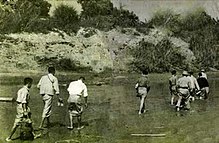| Communist insurgency in Burma | ||||||||
|---|---|---|---|---|---|---|---|---|
| Part of the Cold War and the internal conflict in Burma | ||||||||
 A delegation from the Communist Party of Burma returning by foot to their bases in the countryside after the failed 1963 peace talks. | ||||||||
| ||||||||
| Belligerents | ||||||||
|
|
| ||||||
| Commanders and leaders | ||||||||
|
| |||||||
| Units involved | ||||||||
| Burmese Army |
|
| ||||||
| Strength | ||||||||
|
| 10,000 | |||||||
| Casualties and losses | ||||||||
| 1,352 killed (government estimate in 1952) | Unknown | 741 killed | ||||||
| 3,424 killed in total excluding KMT (government estimate in 1952) | ||||||||
The communist insurgency in Burma (present-day Myanmar) was waged primarily by the Communist Party of Burma (abbr. CPB; colloquially the "white flags") and the Communist Party (Burma) ("red flags") from 1948 to 1989. The conflict ended when the CPB, severely weakened by an internal mutiny, disbanded its armed wing.
- ^ Lintner, Bertil. "Recent Developments on Thai-Myanmar Border. IBRU Boundary and Security Bulletin". p. 72.
- ^ Alfred W. McCoy, with Cathleen B. Read and Leonard P. Adams II (2003). "The Shan Rebellion: The Road to Chaos", from The Politics of Heroin in Southeast Asia: CIA Complicity in the Global Drug Trade (2003 ed.). Lawrence Hill Books. ISBN 1-55652-483-8. Archived from the original on 23 September 2011. Retrieved 8 December 2011.
- ^ a b Fleischmann, Klaus. Die Kommunistische Partei Birmas – Von den Anfängen bis zur Gegenwart. Hamburg: Institut für Asienkunde, 1989. p. 405.
- ^ Meehan, Patrick (2011). "Drugs, insurgency and state-building in Burma: Why the drugs trade is central to Burma's changing political order". Journal of Southeast Asian Studies. 42 (3): 385. doi:10.1017/S0022463411000336. ISSN 0022-4634. JSTOR 23020336. S2CID 56423767. Archived from the original on 15 April 2021. Retrieved 24 December 2020.
From the mid-1960s until Mao's death, China's extensive support for the CPB heralded a more extensive militarisation of the state's opponents.
- ^ a b c Richard Michael Gibson (2011). The Secret Army: Chiang Kai-shek and the Drug Warlords of the Golden Triangle. John Wiley and Sons. p. 88. ISBN 978-0-470-83018-5.
- ^ a b Richard Michael Gibson (2011). The Secret Army: Chiang Kai-shek and the Drug Warlords of the Golden Triangle. John Wiley and Sons. pp. 85–90. ISBN 978-0-470-83018-5.
- ^ Lintner 1990, p. 14.
- ^ Schmid, Alex Peter, A.J. Jongman, and Michael Stohl. Political Terrorism: A New Guide to Actors, Authors, Concepts, Data Bases, Theories, and Literature. New Brunswick, N.J.: Transaction Publishers, 2005. p. 514
Cite error: There are <ref group=lower-alpha> tags or {{efn}} templates on this page, but the references will not show without a {{reflist|group=lower-alpha}} template or {{notelist}} template (see the help page).
